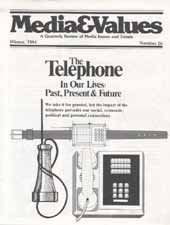Confound it! It Talks!
|
This article originally appeared in Issue# 26
|
Early phone users had to master the 'how' as well as the ‘what for.'
It's the spring of 1876. and people are talking about a new device that promises to handle essential communication tasks previously reserved to humans.
Not surprisingly, its presence raises questions and anxiety. Will it disrupt social relations, throw people out of work, destroy privacy? What will happen to existing systems? Will only business and the wealthy be able to afford it?
During the next century, answers to those concerns about the telephone — yes, the telephone — were ultimately found. Today we take this ubiquitous communications system almost for granted. But to Alexander Graham Bell's bewildered contemporaries, the "talking mouthpiece" was an odd, even ominous, invention.
In fact, recent research on telephone history shows that it was quite a while before the telephone's capacity as a facilitator for direct conversation was understood. Although Bell himself was remarkably prescient (he foresaw the coning of city-wide phone networks which would allow all users to talk to each other at will), many of his contemporaries were completely confused.
Alexander Graham Bell
One 1870's communicator who did not foresee the course of coming development was William Orton, president of Western Union, who refused the chance for his company to buy all rights to the telephone's patent for $100,000.
When he asked, "What use could this company make of an electrical toy?" he clearly did not expect that the telephone would eventually REPLACE the telegraph as society's main communications link.
Radio Telephone
Early demonstrations of the telephone also seem amusingly out of focus as we look back at them. At first, Bell was attempting to use it as more of an early radio, with singers and dramatists transmitting their performances over the line for waiting audiences in distant cities.
Although the demonstrations initially were a promotion device during the period before satisfactory two-way transmission was perfected, they continued later and seem to have helped audiences grasp the unfamiliar principle of long-distance sound transmission.
It's hard for us to estimate the mental shift the telephone required of its early users. "That spoken words could be converted into electrical waves, transmitted along wire and then reconverted into Sound at the other end of the line could not easily be comprehended," according to Sidney H. Aronson, the author of a study of early phone usage. 'Perhaps the best way to understand one of Graham Bell's incredulous contemporaries is to imagine how we would feel if we were told that a way had been devised to make extrasensory perception a means of everyday communication."
Telegraphy
The efficiency and pervasiveness of the telegraph system at the time made this adjustment all the harder. Indeed the telegraph seemed, in 1876, to be the most "normal" means of distant communication in the United States, with 214,000 miles of telegraph wire delivering 31,703,181 telegrams through 8,500 offices! Private lines served federal and local government and specialized telegraph companies were organized by businesses and commercial establishments.
A Social Telegraph Association begun in 1877 in Bridgeport, Connecticut, was even hoping to install instruments in subscribers' homes which could be connected through a central switchboard. Subscribers would be able to "speak" to each other through the switchboard - in Morse code, of course.
Experience with the telegraph also misled Elisha Grey, an inventor who could have invented the telephone at least a year before Bell if he had realized its commercial value. In an analysis of telephone history, Ithiel de Sola Pool and other writers have concluded that Grey and Western Union thought only "of what the telephone could do to extend the EXISTING telegraph system. Bell was a speech expert who approached the problem of telecommunications from the
Because individual and commercial support was focused on the telegraph, it was difficult for the public to accept a need for direct long distance conversation.
"The inventor and his backers thus faced the formidable task of inventing uses for the telephone and impressing them on others," Aronson comments.
Early backers began the patient cultivation of individual customers in order to build up their systems. Development of early exchanges began in 1877. Almost to their surprise, managers of the first district exchanges realized that their subscribers could talk to each other as well as to the central office.
A Twist of Fate
As fate would have it, the fledgling telephone system's quick response to a contemporary tragedy caught the public's imagination and demonstrated the telephone's ultimate value as a means of communication.
The news of a serious railway accident at Tariffville, Connecticut in January, 1878, was telegraphed to the Western Union office in Hartford. The proprietor of a local drugstore had organized a telephone exchange whose subscription list included local doctors and a livery stable.
After the word came in on the night of the accident the drug store clerk telephoned 21 physicians in turn, and then ordered an express wagon from the stable to transport medical supplies to the scene. The resulting publicity on the saving of lives by this quick response gave a huge boost to the idea of the telephone exchange system.
Even the accident, however, did not solve the problem of teaching potential users how the telephone could help them or even how to use the instrument.
Consumers stumbling through today's "user-friendly" computer manuals may take some comfort in knowing that in 1877 a circular was needed to assure the public that "(telephone) conversation can be easily carried on after slight practice and with occasional repetition of a word or sentence."
To paraphrase an old saying, "once upon a time, people learned how to talk over a telephone." The rest, as they say, is history.



